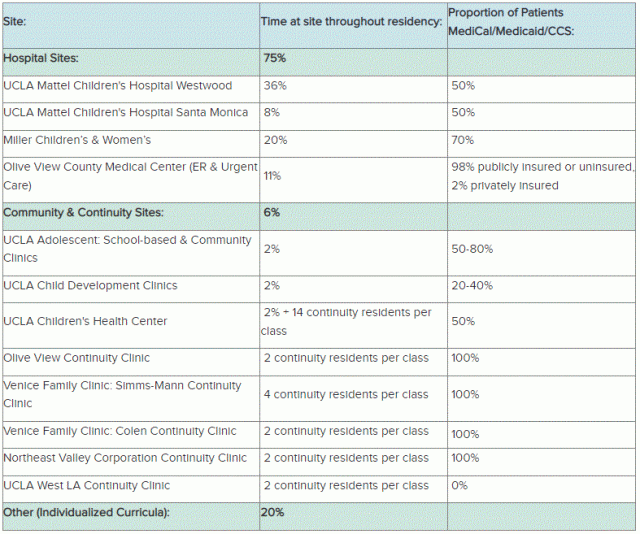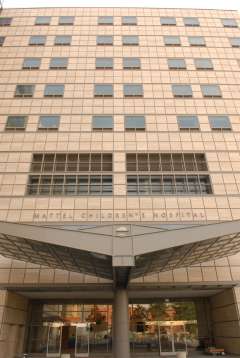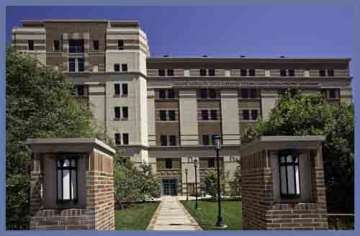Training Sites & Patient Population
Diversity in Training and Patient Populations

The UCLA Pediatric Residency Training Program provides a rich and diverse training experience in a wide spectrum of venues. Throughout their three years of training, residents have the opportunity to train in a broad network of community-based settings and major Los Angeles medical centers including:
- UCLA Mattel Children's Hospital
- UCLA Santa Monica Medical Center
- Miller Children’s & Women’s Hospital
- Los Angeles County Olive View Medical Center
- Community Sites & Partnerships
- Continuity Clinic Sites
The combination of each of these complementary experiences provides for an unparalleled education which is truly rigorous, well-rounded, and unsurpassed for diversity of clinical, economic, and cultural experiences. In all settings in which they rotate, interns are the primary care providers for their patients.
PATIENT POPULATION: Our patients come from the diverse population representing the greater Los Angeles area and a variety of socioeconomic backgrounds. At our various training sites within UCLA hospitals and clinics, UCLA-partners, and community-based settings, residents will primarily see patients that are on Medicare/Medicaid, and California Children's Services provided care. Our residents see patients that are uninsured and privately insured (and everything in-between!). These patients will be seen in a variety of academic settings, community and county hospitals, and FQHC or FQHC look-alike primary clinic sites.

UCLA Mattel Children's Hospital

Ward residents care for patients on either a hospitalist or subspecialty team, with an average of 6-7 patients per intern. As a major referral center, both the Pediatric and Neonatal ICUs offer state-of-the-art advanced critical care services. With faculty and fellows from all disciplines, residents are exposed to cutting-edge tertiary and quaternary pediatric care.
There is an amazing spectrum of illness to which residents are exposed at the 100 bed UCLA Mattel Children's Hospital. In addition to the tremendous breadth of pathology, there is great socioeconomic diversity among our inpatients.
Inpatient Wards (50-beds): Residents rotate on all four day teams throughout their training. The night team, made of 1 senior resident and 2 interns, covers all ward patients overnight.
Team: H/O, Supervisor: H/O fellow/attending, Patient Mix: H/O patients, Resident Mix: 2 senior residents, Typical Census:14
Team: Gold, Supervisor: Renal and Cardiology fellow/attending, Patient Mix: Renal & Cardiology patients, Resident Mix: 1 senior resident, 2 interns, Typical Census:10
Team: Silver, Supervisor: Hospitalist attending, Patient Mix: General Pediatric Consultation, Pulmonology, Genetics, Infectious Disease, A&I, Rheumatology, Resident Mix: 2 senior residents, 2 interns, Typical Census:14
Pediatric Intensive Care Unit (24 beds): With an average of 4 patients per resident per rotation, and 1,100 admissions per year residents have opportunity to care for patients with a wide spectrum of general pediatric and subspecialty critical care problems, including patients receiving heart, liver, small bowel, and renal transplants.
Neonatal Intensive Care Unit (22 beds): Second and third year residents train in the UCLA NICU, a major referral center caring for the highest acuity patients, including those requiring ECMO.
Miller Children's & Women's Hospital
Residents receive training in inpatient general pediatrics, newborn nursery/neonatal resuscitation, and pediatric emergency medicine in this free-standing children’s hospital serving an urban underserved patient population. Rotations at Miller’s provide a tremendous complement to the UCLA-based inpatient experiences. Both pediatric and neonatal experiences provide tremendous exposure to patients with general pediatric and neonatal problems.
Inpatient Ward (~70+): At Miller’s the inpatient ward service has a tremendous mix of high-yield and relevant general pediatric, subspecialty, and surgical patients. The average number of patients per resident is 6-8. The patients admitted to the inpatient pediatric ward reflect the cultural, socio-economic and ethnic diversity of the entire region including a large underserved patient population.
Team: Miller's Wards, Supervisor: Academic Hospitalist, Patient Mix: General Pediatrics/Subspecialty/Surgical, 2 Resident Teams, each with: 2 ward seniors/3 interns, Typical Census: 6-8 patients per intern
Newborn Nursery (~70 beds): Residents receive an exceptionally strong neonatal resuscitation and routine newborn care experience in this setting. The delivery room at Miller’s is one of the busiest in the nation, with 6,000 deliveries per year. Support for residents found in the Neonatal Intensive Care Unit (93 Beds) on site, if a newborn requires a higher level of care.
Miller Children's & Women's Official webpage

UCLA Mattel Children's Hospital at UCLA Santa Monica Medical Center
With a 26-bed general pediatrics inpatient unit floor and a 4-bed Step-Down Unit in a new tower built in 2012, UCLA Mattel Children’s Hospital at UCLA Santa Monica Medical Center provides an excellent environment to care for general pediatric patients. The experience combines a rich blend of common pediatric illnesses, including patients with chronic illnesses and those with no previous medical problems, patients admitted for orthopedic and general surgery, and pediatric solid tumor oncology patients.
Team: Santa Monica Ward, Supervisor: Academic Hospitalist/Community Pediatricians, Patient Mix: General Pediatrics/Solid Oncology/Surgery consultation, Resident Mix: 2 Ward Senior/1 Night Senior/1 Ward Intern/1 Night Intern/2 Family Practice Interns, Typical Census: 14-16 patients
Olive View Medical Center
Residents learn about urgent and emergency pediatrics in this Los Angeles County facility at Olive View. The spectrum of pathology is phenomenal, with excellent teaching from a variety of attending physicians, including academic general pediatricians, community physicians, emergency medicine attendings, and subspecialists, while the education and focus is primarily on caring for the urgently or emergently ill child. At this "safety net" hospital residents also have the opportunity to provide comprehensive care to underserved patients including participation in some subspecialty care clinics in addition to managing a small general inpatient ward. Two residents per training year have their continuity clinic site at Olive View.
Los Angeles County Olive View Medical Center Official webpage
Community Sites & Partnerships
Resident education in Community Pediatrics is rooted in the required training blocks in Community Medicine, Developmental Pediatrics, Adolescent Medicine, Child Advocacy, Ambulatory Pediartrics and Urgent Care. In addition, residents may elect experiences in general community practice as well as child abuse and neglect. Overall, this robust curriculum reflects our commitment to providing residents with the tools necessary to becoming community providers and leaders for the 21st century.
Developmental Pediatrics
This experience includes hands-on training in both outpatient developmental assessments and inpatient consultations. In addition, residents rotate through a variety of community settings, gaining clinical experience with a developmental focus. These experiences include visits to rehabilitation facilities such as the Blind Children's Center and the John Tracy Center for the Deaf and Hard of Hearing, speech therapy sites, schools for children with disabilities, specialized developmental clinics in learning and attention disorders, autism, and educational advocacy, and a local Regional Center.
Adolescent Medicine
Adolescent Medicine includes great experiences in multiple venues including the Adolescent Medicine Clinic at UCLA, multiple school-based clinics, the Robert Levine Teen Center at the Venice Family Clinic, and the Student Health Center at California State University at Northridge.
Residents gain exposure to forensic pediatrics, Medical Home issues for children in foster care, and working with children with special health care needs. Residents will also work on an asset-mapping project and participate in educational sessions held with the California Chapter of the AAP.
In this rotation residents refine their ambulatory pediatrics skills in community-based settings. Most of the clinical experiences occur at the Simms-Mann Health and Wellness Center and the Rose site of the Venice Family Clinic. Residents are also exposed to a busy managed-care practice at a Kaiser Permanente facility in Torrance.
UCLA Primary Care Clinic, Urgent Care (next door to Mattel Children's Hospital)
Residents gain experience with both urgent and well child care. The patient population spans from healthy children to medically complex children with acute health concerns. Interns also have a terrific learning experience fielding parent calls from the community.
Continuity Clinic Sites
In each continuity clinic, residents provide comprehensive care to their panel of pediatric patients. As part of the continuity clinic training experience, residents have the opportunity to develop a continuous quality improvement project to enhance patient care in their unique clinic setting. Residents also participate in small group learning on general pediatric topics and best practices in their weekly clinic sessions. Current sites include:
- The Primary Care Center at UCLA: In addition to being the primary care continuity site for 50% of the residency program, first and second year residents also rotate through urgent care at the UCLA outpatient Children's Health Center.
- Colen Children’s Health Center
- South Valley Health Center
- Simms-Mann Health and Wellness Center
- UCLA West L.A. Pediatrics Clinic in Santa Monica
- OV Continuity Clinic (an LA County clinic located at Olive View Medical Center)